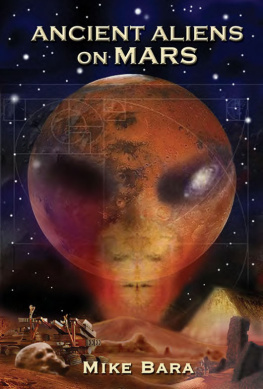Contents
Page List
Guide
life on mars
life on mars
what to know before we go
david a. weintraub
With a new afterword by the author
princeton university press
princeton and oxford
Copyright 2018 by Princeton University Press
Afterword to the paperback edition, copyright 2020 by
Princeton University Press
Published by Princeton University Press,
41 William Street, Princeton, New Jersey 08540
In the United Kingdom: Princeton University Press,
6 Oxford Street, Woodstock, Oxfordshire OX20 1TR
press.princeton.edu
Jacket/Cover image: View toward Vera Rubin Ridge on Mount Sharp, Mars / NASA/JPL-Caltech/MSSS
All Rights Reserved
First paperback printing 2020
Paperback ISBN 978-0-691-20925-8
Cloth ISBN 978-0-691-18053-3
Library of Congress Control Number: 2020936111
British Library Cataloging-in-Publication Data is available
This book has been composed in Odibee Sans & Sabon Next LT Pro
Printed in the United States of America
contents
For Caren Levy Burgess & Alan Burgess & My West Coast parents, Dot and Gerry Levy
So much nonsense has been written about the planet that it is easy to forget that Mars is still an object of serious scientific investigation.
CANADIAN ASTRONOMER PETER M. MILLMAN,
IS THERE VEGETATION ON MARS, THE SKY, 3, 1011 (1939)
life on mars
why mars matters
Are we alone in the universe? Earth might be an oasis of life, the only place in the universe where living beings of any kind exist. On the other hand, life might be as common across the universe as the hundreds of billions of stars and planets that populate it. If life is common, if the genesis of life is fairly easy given the right environment and the necessary elemental materials, some form of life might exist right next door, on Mars, and if life were discovered on Mars that is of an independent origin than life on Earth, we could safely predict that life is common throughout the universe. Such a discovery would be extraordinary. Mars Matters.
Mars has always attracted the attention of sky watchers on Earth, whether as the Greek (Ares) or Roman (Mars) or Babylonian (Nirgal) or Hindu (Mangala or Angaraka) God of War, or as the Chinese (Huo Hsing) or Japanese (Kasei) Fire star. The Incas named this planet Auqakuh; in ancient Sumer, it was called Simud; in ancient Hebrew, Maadim. Everywhere and for all of remembered history, Mars always had a name. We have been watching it for as long as weve been looking up into the heavens. As a planet (a wandering star, in the vernacular of the ancient Greeks), Mars stood out as a special object in the sky, comparable in brightness only to Venus, Jupiter, and Saturn, but even without a telescope, Mars is more colorful in the nighttime sky than the other planets, appearing red in color much of the time. Perhaps that is the lure of Mars. Perhaps the appeal of Mars in an ancient sky full of gods, in a celestial tapestry of myths, led us to imagine Mars as a place more special than all the other places we might visit in our imaginations.
We have been attracted to the idea of life on Mars for a very long time, by turns led and misled by our desires and imaginations. Thousands of years of human history, in which humans across all cultures invested the bright red planet with enormous mythological importance, combined with the medieval and Renaissance-era expectation that almost all other worlds should be inhabited, may have led astronomers to expect to find that Mars was Earthlike, and so they may have found what they wanted to find. The picture of Mars that emerged after the invention of the telescope revealed that the fourth planet from the Sun shares many life-critical similarities with Earth. With that realization, it was natural for astronomers to draw the conclusion that Mars must also be capable of hosting living things. As we approach a time when we might colonize Mars, we need to understand the burden of historical expectations regarding life on Mars that we all shoulder, because the history of discoveries about Mars made over the last four hundred years motivates todays scientists as they explore and study the red planet.
Does life exist on Mars? Maybe. Are the Martians Little Green Men? Not likely. Could primitive microorganisms survive on Mars, living in subsurface reservoirs of liquid water? Yes. Long ago, could spores have been transferred via a large impact event from Mars to Earth or from Earth to Mars? Very possibly.
We know that the six most important elemental building blocks of lifecarbon, oxygen, nitrogen, hydrogen, phosphorous, and sulfurexist virtually everywhere in the universe. The backbone of chemical life as we know it is carbon, which is abundant on Mars. Mars also has plenty of nitrogen and phosphorous, which are necessary components of both amino acids and DNA. We know Mars has water, which is made of hydrogen and oxygen, so those two elements, both together as water and separately for other chemical processes, are readily available. Sulfur, which occurs in all sugars, proteins, and nucleic acids, is also abundant on Mars. Chemically, at least, Mars has all the right stuff for the origin and survival of chemically based life. In addition, Mars has spent part of the last 4.5 billion years since the birth of the Sun in the Goldilocks zone of our solar system, where temperatures, pressures, and densities are just right to allow liquid water to exist on or just below the Martian surface for at least part of Marss annual cycle of seasons.
In principle, Mars could therefore harbor life, whether as a birthplace for living things or as a nurturing environment for life-forms that might have been deposited there. Furthermore, Mars may be a model for helping us understand the likelihood that life could exist on any of the many exoplanets recently discovered by astronomers that lie in the Goldilocks zones around their host stars.
Some scientists have speculated that life in our own solar system may have started on Mars and later been accidentally exported to Earth when a large asteroid collided with Mars and splashed Martian rocks into space. Alternatively, though dynamically more difficult, life may have started on Earth and, as the result of a large terrestrial impact event, been transported to Mars, in which case Mars could function as a nurturing environment for life-forms that might have been deposited there after forming elsewhere.
Earth and Mars formed at about the same time, almost 4.5 billion years ago, in a swirling disk of gas and dust that orbited the newborn Sun. After suffering through the traumatic early stages of formation, in which large asteroids and myriad comets likely continually crashed into their surfaces for several hundred million years, the solar system stabilized. As soon as the planets cooled enough for solid land to begin to form, both Earth and Mars almost certainly also had liquid water pooling on their surfaces.
On at least one of these two planets, life made an appearance fairly soon after these primordial formation events. Australian geologist Allen Nutman and his scientific team recently pushed the time for the oldest known living things on Earth all the way back to 3.7 billion years ago. In a rock formation in Isua, Greenland, they found layered structures that prove that the rock itself is a stromatolite. Such rocks form as colonies of microorganisms deposit layers of minerals as they grow. From Nutmans work, we therefore know that stromatolites thrived in shallow seas on Earth when our planet was only 800 million years old. Incredibly, life must have taken root on Earth very quickly after it formed. Equally certainly, Mars was also warm and wet when it too was only 800 million years old. If so, then life could have formed or grabbed hold on Mars at about the same time. Thus, the existence of stromatolites on a young Earth strongly suggests that a young Mars, too, could have had colonies of primitive living things in its shallow lakes.












